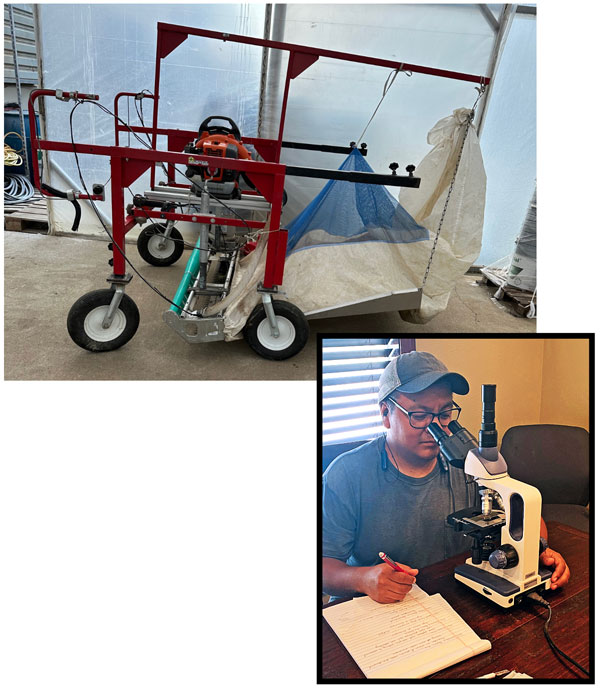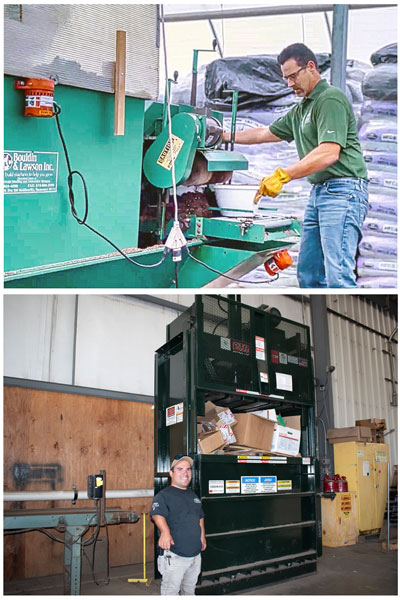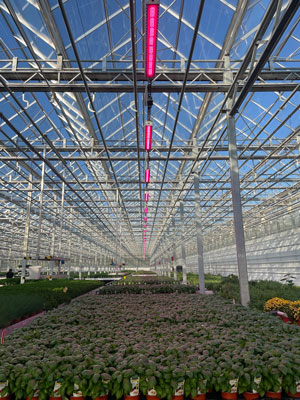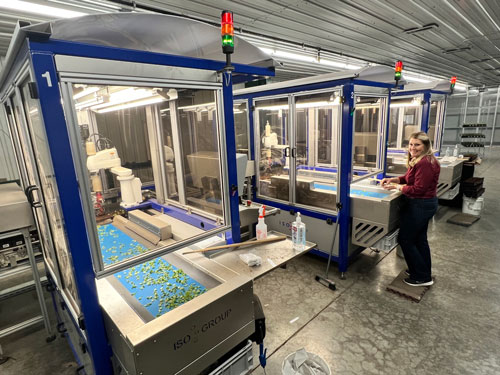3/1/2024
Why Did I Wait So Long? (Part 2)
Chris Beytes
Here’s a question for you: Is there a greenhouse tool or technology that you resisted investing in, for whatever reason, and now it works so well that you kick yourself for not buying it sooner?
GrowerTalks put that question to a dozen growers who we know have invested in a lot of tools and technologies over the years. The answers were varied and spirited—and plentiful! So plentiful, in fact, that we split this article across two issues so’s not to have to leave any detail on the cutting-room floor. Part 1 was last October. Here’s the second half of the story, featuring six more growers and their nine favorite “Why-did-I-wait-so-long?” tools.

Ken Altman, Altman Plants—Vista, California
One tool comes to mind quickly. When first introduced to EZ Trimmer I could see that it would be very useful in cutting plants evenly and quickly. But at around $20,000 it offended me as it seemed that it should be much cheaper based on cost of manufacturing. But after some time I got used to the idea and got one, and over time, many of them so each of our locations has one. We can cut hundreds of thousands of poinsettias now in a breeze and we save days and days of manual pinching labor. Plus, we changed an unpleasant difficult job into something easy.
A couple of lessons learned: make sure the trimmer rolls on an even surface so the height of cut stays consistent. And make sure that when it is time to space the branching poinsettias that you have enough spacing labor. It’s easy to pinch more plants than you have time to separate later.
One other nice tool is an add-on to Harvest Automation robots. These are the autonomous robot units that can space and consolidate plants. We’ve been able to add a dispenser that drops dry fertilizer into each pot as they’re being separated. Again, a big savings of time.
Jonathan Cude, Sedan Floral—Sedan, Kansas
A microscope? That’s Sedan’s best recent investment.
“We should have bought one ages ago,” said CEO Jonathan Cude. “For a few hundred dollars we can see our roots in a whole new way. It has allowed us to positively identify fungal issues and then treat accordingly. No more guessing. It has made a huge impact on our growing and paid for itself immediately.”
The brand is Swift, Jonathan said. They bought it on Amazon for about $300. Pictured is Cesar Dominguez checking out some roots.
Jerome Vite, Vite Greenhouses—Niles, Michigan
“We used to think we ran a pretty efficient operation—new greenhouses, climate control, inventory management,” said co-owner Jerome Vite. “But one machine we didn’t have until about five years ago was a flat filler.”
But why mechanize when you have kids around? That was the philosophy of Jerome and his brothers.
“My brothers and I had sons who needed to stay busy, so we used them to fill planting boxes after school from 3 cu. ft. loose-fill bags. We never had a flat filler when we were younger and we thought dumping bags of media in a box was a character builder.”
 But the boys went off to college or other jobs, and Jerome and his brothers needed a better plan—one that was easier on their aging backs.
But the boys went off to college or other jobs, and Jerome and his brothers needed a better plan—one that was easier on their aging backs.
“We had always talked about a flat filler, but pooh-poohed the idea until about five years ago when we learned from our BFG rep that a Kalamazoo grower was selling his 25-plus year old Bouldin & Lawson flat filler for $2,500. We decided to go for it and now wished we had done it years before.”
Jerome said the machine let them use larger bags of potting mix, which saved them money. It also freed up employees for the more important job of planting.
“The year we purchased the filler, our total production stayed 4% to 5% ahead of the previous year. Plugs for production didn’t pile up in late March like they did when we didn’t have the flat filler,” added Jerome. “We decided to purchase a new Kase flat filler at Cultivate this year. We will continue to use the old machine specifically for flats.”
Bill Swanekamp, Kube-Pak—Allentown, New Jersey
We knew Bill, one of the industry’s most astute numbers guys, would have some good examples, and he delivered four:
Shipping carts. Even as the industry began switching to rolling shipping racks about 35 years ago, Kube-Pak continued to use their own shipping method: steel boxes on a 48-ft. flatbed trailer, filled with flats. As the demand for hanging baskets and patio pots grew, their shipping method became obsolete. But changing would be expensive, requiring thousands of carts, enclosed trailers and lift gates all costing millions of dollars.
“Because the cost was so high, we hesitated to do it right away and all at once,” recalls Bill. “In hindsight, we should have made the change many years before we did and just bit the bullet of the expense. We cannot imagine doing our shipping today without the use of the cart system.”
Replacing an old transplanter. Kube-Pak bought their first transplanter, a TTA, 23 years ago, and up until two years ago they continued to repair the old machine and use it for spring planting. Finally, TTA said they could no longer replace its key components—it was just too old. This forced them to purchase a new transplanter at twice the price of the old one.
“Ouch!” said Bill. But “Lo and behold, what we discovered was that the new machine transplanted so much better than the old one that it almost eliminated having to fix transplanted flats in the greenhouse. We have saved a ton of money with the new machine. This is another example of waiting too long to replace an essential piece of production equipment.”
Replacing original environmental controls. Kube-Pak installed its first computer environmental controls back in the 1990s. It was still under development and plagued with problems and reliability issues. And it was expensive to install and maintain. But because of the investment they’d put into it, they were reluctant to replace it.
Recalls Bill, “As with the other items I mentioned, we took too long to replace the system, but once we started the process and completed it, the results were fantastic. This replacement cost over half a million dollars, but has been some of the best money we ever spent. We now have a reliable computer control system and accurate input. This translates into better crop production and less stress for the maintenance department.”
Cardboard compactor. A good example of a small investment saving a lot of time, which translates into money, said Bill. Kube-Pak roots millions of cuttings each year, which results in a large amount of waste cardboard packaging. They would fold it and wrap it by hand for disposal with the local garbage company, which was costing them $250 per week—$13,000 per year—plus a large amount of labor to load the container.
“One day we visit George Lucas and saw he had a cardboard compactor,” Bill recalls. “My son Sean got all excited and said, ‘We need one of them.’ It cost just over $13,000 for the new compactor. Now we get the cardboard taken away for free. A great investment!”
Mike Gooder, Plantpeddler—Cresco, Iowa
“The thing that’s really blown me away is the Metazet FormFlex combined with the Oasis Water by Weight,” said Plantpeddler founder Mike Gooder when we spoke by phone. “That combination is insane in what it has allowed us to do with the amount of baskets we produce. It’s a total game-changer.”
If you’re not familiar with either tool, the Metazet FormFlex is a hanging basket conveyor system that uses a dry cleaner-style chain-in-track that can turn corners and change elevations. Sections can be lowered to ground level for loading and unloading, then raised back up again. The Oasis Water by Weight by ControlDekk does what it says: it weighs the baskets as they pass through it to determine how much water to give each basket rather than working strictly by time, like other systems.
Mike, a long-time user of stationary and carousel basket systems, first saw the Metazet FormFlex as far back as five years ago, but couldn’t justify the high cost.
“We knew stationary lines were inexpensive and we bought most of our carousels used. Then we looked at the cost of the Metazet thinking, ‘This is kinda crazy just to produce baskets.’ But we produce 200,000 baskets a year, and if we can produce baskets faster and safer …”
A new extra-tall greenhouse, impractical and unsafe for standard basket systems, prompted Mike to give the Metazet FormFlex a try. And, boy, what a difference! They went from two turns of baskets to four, said Mike. One person can be unloading baskets for shipping while another person can be reloading with new baskets. Water-by-weight allows them to optimize the irrigation for a blend of older and younger baskets, keeping all the lines full. It’s great for scouting and spraying baskets, too, as they can drop the baskets down to ground level and run them past the spray operator.
“And it’s all done with people at ground level, with their feet on the ground,” he said.
More benefits include water and fertilizer savings (10% to 20%), and the ability to grow more difficult crops in the air, like mums and poinsettias.
“We wouldn’t even consider using our other systems for those types of crops because we can get to them to spray, apply fungicides, put in sticky cards … that’s not anything you can do with a carousel or stationary basket line.
“I’ve done some crazy investments, but I’m just totally stoked by this system.”

Doug Cole, D.S. Cole Growers—Louden, New Hampshire
For Doug Cole, one “why-not-sooner?” investment is LED lighting, which they’re using to grow 4-in. herbs for a supermarket chain. Doug said he knew the crop took almost twice as long to finish in the winter versus the summer and that lights could shorten that by a week or so. But “that by itself did not justify the expense in my mind,” he told us. “My concern has been the economics of lights based on the crop. When we are growing in natural light, and we are only supplementing for a few hours each day and the lights are used for a few months of the year, it gets difficult to determine payback with the high cost of LEDs.”
But he eventually gave in and gave them a try. Yes, they cut a week off their winter growing time, but what really surprised Doug was the improved quality of the product.
“Normally, basil leaves are somewhat pale in the winter under natural daylight. The LED lighting made the color of the leaves a rich green color that surpassed our summer results.”

Amy Morris, N.G. Heimos Greenhouses —Millstadt, Illinois
“That is an absolute YES!” said co-owner Amy Morris when I asked her our question via phone. “There are so many things, but the biggest and most recent is the ISO machine.”
ISO is ISO Groups’ Cutting Planter 2500, which uses cameras, a computer, a robot arm and special grippers to stick unrooted cuttings. There are more than 300 of them in service now and growers report major labor-savings. Amy had been watching the ISO in action since about 2016 and saw their potential for Heimos’ liner production, especially for their multi-variety combination liners. However, the high cost was discouraging; plus, they’d just started with the government’s H-2A temporary agricultural workers program and they felt that would help solve their labor issues.
Still, “each year at Cultivate I’d salivate over these machines,” Amy said.
In 2021, they decided to take the plunge, installing three machines, which would let them plant three varieties into one liner. They saw the benefits almost right away.
Reports Amy, “We used to have a line of 12 ladies working just on combo liners. We reduced that to three people running those machines.”
Those nine extra workers could now be put on other tasks, like spacing and pinching—“Jobs we weren’t getting done because our focus was just on trying to get unrooted cuttings into the ground.”
A major unexpected benefit is the ability to direct-stick any size container, from a 144-cell up to 4-in. pots. In fact, they grow about 1 million 4-in. accent plants (hedera, ipomoea, vinca and the like), and about 80% of those were direct-stuck by the ISOs.
“I could shoot myself for not pushing harder,” admitted Amy. “Now I want three more!” GT